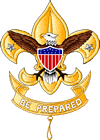Outdoor Program
Outdoor adventure is the promise made to boys when they join Scouting. Boys yearn for outdoor programs that stir their imagination and interest.
In the outdoors, boys have opportunities to acquire skills that make them more self-reliant. They can explore canoe and hiking trails and complete challenges they first thought were beyond their ability. Attributes of good character become part of a boy as he learns to cooperate to meet outdoor challenges that may include extreme weather, difficult trails and portages, and dealing with nature's unexpected circumstances.
Scouts plan and carry out activities with thoughtful guidance from their Scoutmaster and other adult leaders. Good youth leadership, communication, and teamwork enable them to achieve goals they have set for themselves, their patrol or squad, and their troop or team.
Learning by doing is a hallmark of outdoor education. Unit meetings offer information and knowledge used on outdoor adventures each month throughout the year. A leader may describe and demonstrate a Scouting skill at a meeting, but the way Scouts truly learn outdoor skills is to do it themselves on a troop outing.
Scouting uses the patrol method to teach skills and values. Scouts elect their own patrol leader and they learn quickly that by working together and sharing duties, the patrol can accomplish far more than any of its members could do alone. The patrol succeeds when every member of the patrol succeeds and Scouts learn that good teamwork is the key to success.
Exercise and fitness is part of the outdoor experience. As Scouts hike, paddle, climb, bike, or ride, their muscles become toned and their aerobic capacity increases. When they work as a patrol to plan menus for their outings, they learn to purchase cost-effective ingredients to prepare flavorful and nutritious meals.
Service to others and good citizenship is learned through such outdoor activities as conservation projects, collecting food, building trails and shelters, and conducting community service projects that promote healthy living. Through helping other people, Scouts learn to appreciate how they can share themselves and their blessings to those in need. By giving service to benefit others, Scouts gain a sense of personal satisfaction.
Types of Outdoor Programs
What are typical Scout outdoor activities? For younger Scouts, less-rugged activities are more appropriate as they begin to acquire outdoor knowledge and skills. These may include:
Day hikes—Reasonably short hikes (3 to 10 miles) in terrain without a lot of elevation gain or loss.
Service projects—Daylong projects that may be related to conservation, food collection, building shelter, or healthy living activities.
Patrol activities—A Boy Scout patrol or Varsity Scout squad may hike or camp with other patrols or squads in the unit or, with the permission of their Scoutmaster and parents or guardians, may hike or camp on their own.
Weekend overnights—Troops that plan and carry out outings once a month attract and retain boys at a much higher level than those that have fewer outings during the year.
Camporees—Councils and districts plan camporees and other outings during the year that give Scouts an opportunity to test their knowledge and skills in competitive events with other troops and patrols.
Summer camp—Summer camp is what many Scouts enjoy most. Camp programs provide numerous opportunities for Scouts to earn merit badges along their advancement trail. Resident Scout camping includes at least seven nights and six days of fun outdoor activities.
Jamborees—Every four or five years, the Boy Scouts of America hosts a national Scout jamboree. More than 40,000 Scouts and leaders from across the country participate in this 10-day event filled with the most popular and highest quality outdoor activities Scouts enjoy. To participate, a Scout must be at least 12 years of age by July 1 of the jamboree year and be a First Class Scout.
Council high adventure—A high-adventure experience includes at least five nights and six days of trekking in wilderness and other rugged, remote locations. Trekking may include backpacking, canoeing, mountain biking, horse packing, mountain climbing, ski touring, rafting, kayaking, or a host of other outdoor adventures. Participants must be at least 13 years old by January 1 of the year they participate.
National high adventure—The BSA operates national high-adventure bases and programs. With two locations in the Florida Keys, the Florida National High Adventure Sea Base offers a variety of aquatic and boating programs. The Northern Tier National High Adventure Program, based in northern Minnesota with two satellite bases in Canada, provides a variety of canoe treks and programs. Philmont Scout Ranch and the Double H Ranch in the mountains of New Mexico provide excellent backpacking treks. Age requirements for these programs vary, but most programs are rugged and designed for older Scouts.
Unit high adventure—The highest level of challenge for a troop or team is to plan and carry out its own high-adventure experience. These activities for more experienced Scouts are planned and implemented by youth members with coaching from their adult leaders.
